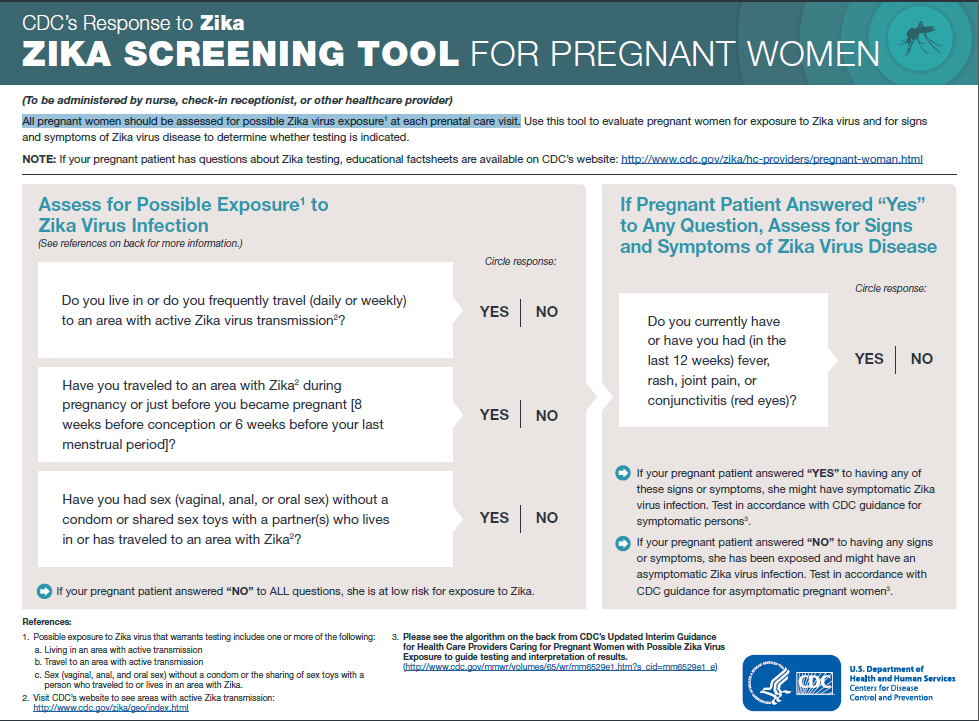Attachment D_ScreenShot for HCP SurveysCONUSandPR
Attachment D_ScreenShot for HCP SurveysCONUSandPR.docx
CDC and ATSDR Health Message Testing System
Attachment D_ScreenShot for HCP SurveysCONUSandPR
OMB: 0920-0572
OMB No. 0920-0572
Expiration Date 3/31/2018
Domestic Readiness Initiative For Zika Virus Disease
Task 10
Materials
Clinical Guidance 1: Preconception Counseling
Health care providers should discuss couples’ travel plans in preconception counseling. Women and men who are planning to conceive in the near future should consider avoiding nonessential travel to areas with active Zika virus transmission. Women who have had possible Zika virus exposure through travel or sexual contact and do not have ongoing risks for exposure should wait at least 8 weeks from symptom onset (if symptomatic) or last possible exposure (if asymptomatic) to attempt conception. Women who wait at least 8 weeks to conceive might have an increased likelihood that Zika virus no longer presents a risk for maternal-fetal transmission. CDC now recommends that men with possible Zika virus exposure, regardless of symptom status, wait at least 6 months from symptom onset (if symptomatic) or last possible exposure (if asymptomatic) before attempting conception with their partner.
CDC previously recommended that men with possible Zika virus exposure who were asymptomatic wait at least 8 weeks from last possible exposure. The updated recommendation minimizes the likelihood that periconceptional sexual transmission will result in fetal exposure to Zika virus. The recommendation to wait at least 6 months for asymptomatic men is based on the range of time after symptom onset that Zika virus RNA has been detected in semen of symptomatic men and the absence of definitive data that the risk for sexual transmission differs between symptomatic and asymptomatic men. Zika virus has not been definitively cultured from semen more than 3 months after symptom onset. It is unknown whether detection of Zika virus RNA in semen indicates presence of infectious virus and the potential for transmission. Current recommendations provide couples planning to conceive with periods that, based on existing data, are expected to minimize risk for Zika virus transmission to an uninfected partner. Studies are underway to better understand the persistence of infectious Zika virus in semen and the associated risk for sexual transmission of the virus. Given that limited data are available, some couples in whom a partner had possible Zika virus exposure might choose to wait longer or shorter than the recommended period to conceive, depending on individual circumstances (e.g., age, fertility, details of possible exposure) and risk tolerance.
|
Clinical Guidance 2: Zika Screening Tool for Pregnant Women |

Clinical Guidance 3: Prevention of Sexual Transmission |

Puerto Rico Materials
Clinical Guidance 1: Prevention of Sexual Transmission |

Clinical Guidance 2: Interim Guidance for Preconception Counseling and Prevention of Sexual Transmission
Persons living in an area with active Zika virus transmission should be counseled on the possible risk for Zika virus infection during the periconception period. CDC has developed tools to assist health care providers with preconception counseling. Health care providers should provide counseling about the potential consequences to the fetus associated with Zika virus infection during pregnancy, such as microcephaly and other serious brain abnormalities. Women and men should discuss their reproductive life plans with their health care provider, in the context of potential and ongoing Zika virus exposure. Health care providers should review factors that might influence pregnancy timing (e.g., unknown duration of Zika virus outbreak, fertility, age, reproductive history, medical history, personal values and preferences). For couples who choose to conceive, health care providers should stress use of mosquito bite prevention strategies while attempting pregnancy and during pregnancy. Health care providers should counsel couples who decide to wait to attempt conception about strategies to prevent unintended pregnancy, including the most effective contraceptive methods (i.e., long-acting reversible contraception) and provide contraception or referral to appropriate providers for contraception care. |
Public reporting burden of this collection of information is estimated to average 10 minutes per response, including the time for reviewing instructions, searching existing data sources, gathering and maintaining the data needed, and completing and reviewing the collection of information. An agency may not conduct or sponsor, and a person is not required to respond to a collection of information unless it displays a currently valid OMB control number. Send comments regarding this burden estimate or any other aspect of this collection of information, including suggestions for reducing this burden to CDC/ATSDR Reports Clearance Officer; 1600 Clifton Road NE, MS D-74, Atlanta, Georgia 30333; Attn: OMB-PRA (0920-0572)
| File Type | application/vnd.openxmlformats-officedocument.wordprocessingml.document |
| Author | Alex Mijares |
| File Modified | 0000-00-00 |
| File Created | 2021-01-25 |
© 2025 OMB.report | Privacy Policy